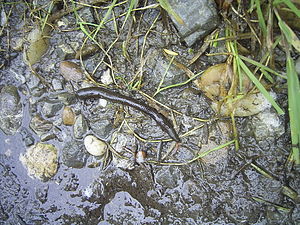Jaw rule
| Jaw rule | ||||||||||||
|---|---|---|---|---|---|---|---|---|---|---|---|---|

Flukes of the genus Haemopis in the Donau-Auen National Park |
||||||||||||
| Systematics | ||||||||||||
|
||||||||||||
| Scientific name | ||||||||||||
| Hirudiniformes | ||||||||||||
| Caballero , 1952 |
The Kieferegel (Hirudiniformes, formerly Gnathobdelliformes or Gnathobdellida Vaillant , 1890 ) are a suborder of the flukes (Hirudinea) as parasites in different vertebrates and or predatory life of other small animals. The classification of this group has recently been revised.
features
The body of the jaw rule is divided into 33 segments and a prostomium at the front end . The segments cannot be seen from the outside due to the external curling. The front suction cup is made up of the 4 first segments and the rear suction cup is made up of the 7 last segments. The male sexual opening of the hermaphrodite animals is in the ninth and the female in the tenth segment. The jaw rules have 5 pairs of eyes.
In most species, the foregut of the jaw rule has three strong, serrated jaws that are used to scratch the host's skin. Some species, including the horse leech , have poorly developed jaws and devour prey as a whole. The latter do the same since the revision by Borda et al. (2008) associated primitive jawless leeches with this taxon. The stomach of the jaw rule is usually very flexible to absorb large amounts of food and has paired bulges to store the food. Predatory leeches such as horse leeches have no or only poorly developed blind sacs.
The coelom of Kieferegel is like the throat leeches formed as a system close vessels through which the hemoglobin-containing , as blood flows serving coelomic fluid and therefore constitute a secondary vascular system, while the primary vascular system is fully reduced. The two laterally running muscular main vessels pulsate and thus have a cardiac function . The space between the vessels is criss-crossed with muscle cords and filled with connective tissue.
The hermaphrodite animals have a penis with which the sperm is transferred directly and without spermatophore into the gonopore of the sex partner.
Occurrence, habitat and species examples
Most of the pine rules are aquatic and are particularly common in inland waters around the world. There are also terrestrial species, especially in the tropics of Asia .
The medicinal leech ( Hirudo medicinalis ) and the Mediterranean medicinal leech ( Hirudo verbana ) from the family Hirudinidae live in inland waters of Europe and suck blood from vertebrates. The horse leech ( Haemopis sanguisuga ) from the Haemopidae family, which also lives in freshwater, and the European land leech ( Xerobdella lecomtei ) from the Xerobdellidae family , on the other hand, eat insect larvae and annelid worms, which they devour as a whole. The Peruvian species Tyrannobdella rex from the family Praobdellidae is a very small species that also penetrates the nasal and pharynx cavities of humans to suck blood . The landing leeches (Haemadipsidae) live in the forests of South Asia , Southeast Asia , Australia and Madagascar , where they infect mammals as blood-sucking parasites and some species can also bite through human leather clothing.
Systematics
Peter Ax names the autapomorphism of the monophyletic group Gnathobdelliformes or Hirudiniformes as the three toothed jaws or semicircular saw blades, between whose teeth the hirudin- forming salivary glands open, as well as the direct transfer of sperm with the help of a penis and without spermatophores. According to the traditional system, leeches belong to the following families , whose representatives have three, in the case of landing leeches sometimes only two jaws and in the case of the Praobdellidae only one jaw:
- Hirudinidae (bloodsucking, aquatic, 3 jaws)
- Macrobdellidae (blood-sucking, aquatic, 3 pine, formerly part of Hirudinidae)
- Haemopidae (predatory, aquatic, 3 jaws)
- Haemadipsidae (the actual landing leeches: bloodsucking, terrestrial, 2 to 3 jaws)
- Xerobdellidae (predatory or blood sucking, terrestrial, 3 jaws)
- Praobdellidae (blood sucking, persistent parasites on mucous membranes, 1 to 3 jaws)
Based on molecular genetic studies by Borda et al. (2008) the Hirudiniformes taxon also includes the following families, which include primitive, predatory, jawless flukes and which without the traditional jaw rule would form a paraphyletic taxon:
A branch near the base of the trunk-less leeches represents the following family of terrestrial predatory leeches:
literature
- Peter Ax: The system of Metazoa II. A textbook on phylogenetic systematics. Gustav Fischer Verlag, Stuttgart / Jena 1999. Chapter Hirudinea , pp. 65–73.
- Urania Tierreich , Volume 2. Urania-Verlag, Leipzig / Jena / Berlin 1966. P. 80, order Gnathobdelliformes, Kieferegel .
- C. Wesenberg-Lund, O. Storch: Biology of freshwater animals - invertebrates. Published by Julius Springer, Vienna 1939. p. 362.
- Hugh F. Clifford: Aquatic Invertebrates of Alberta: An Illustrated Guide. University of Alberta Press, Edmonton (Alberta) 1991. pp. 70-85.
- Elizabeth Borda, Alejandro Oceguera-Figueroa, Mark E. Siddall (2008): On the classification, evolution and biogeography of terrestrial haemadipsoid leeches (Hirudinida: Arhynchobdellida: Hirudiniformes). Molecular Phylogenetics and Evolution 46 (1), pp. 142-154.
Web links
- Gnathobdelliformes in: Lexicon of Biology , online edition.